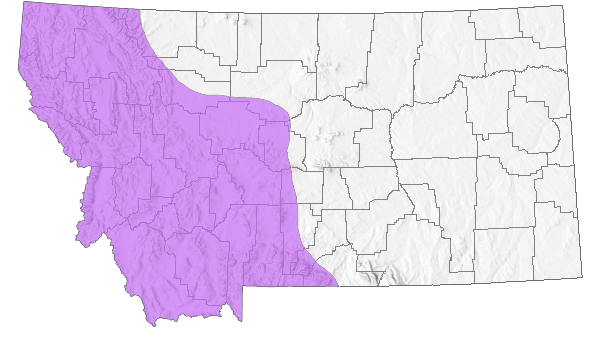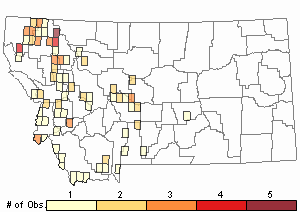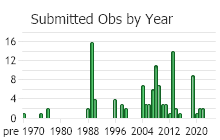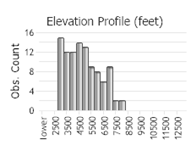View in other NatureServe Network Field Guides
NatureServe
Montana
Utah
Wyoming
Idaho
Wisconsin
British Columbia
South Carolina
Yukon
California
New York
Meadow Horsetail - Equisetum pratense
State Rank Reason (see State Rank above)
Equisetum pratense has accurately been identified to occur in a few places within Lake, Powell, and Meagher counties of Montana. Observations in other counties need to be verified because Equisetum pratense can easily be mis-identified. Specimens deposited in herbaria outside of Montana will also need to be examined before it can be demonstrated that this plant is more widely distributed.
General Description
Plants: Rhizomatous perennials. Stems annual, vegetative and fertile stems differing; central cavity < 2/3 the stem diameter (Lesica 2012); stem bases smooth; upper stem ridges with spreading, high, siliceous tubercles or transverse crests on the ridges (Hitchcock et al. 1969). Vegetative stems annual, 5–30 cm tall (Lesica 2012) or sometimes up to 50 cm (FNA 1993), 1–2 mm in diameter, ascending or erect, 10-18-ridged, pale green and branched (Lesica 2012), the central cavity 1/6 to 1/3 the diameter of the stem. Fertile stems are unbranched and brown (FNA 1993) in spring, becoming branched and green following spore release later in the season (Lesica 2012); both sheaths and teeth are longer on fertile stems than on vegetative stems (Hitchcock et al. 1969).
Branches: Occurring in regular whorls, ascending to widely spreading and arched (Hitchcock et al. 1969), solid (unlike main stem), with channeled valleys and 3 ridges; sheaths 3-5 x 2-4 mm (FNA 1993), green, slightly flared; the sheath teeth 1.5-3.2 mm, membranaceous, acuminate (McGregor et al. 1986) with a dark center and light margins (Lesica 2012), triangular, 8-18 in number; stem sheath shorter than first internode of the branch above it (FNA 1993).
(
Lesica et al. 2012. Manual of Montana Vascular Plants. BRIT Press. Fort Worth, TX)
Phenology
Cones mature in late spring (FNA 1993).
Diagnostic Characteristics
Equisetum pratense and E. arvense have sterile stems that are similar in appearance. The siliceous tubercles of E. pratense are high and conspicuous, whereas in E. arvense, they are low and inconspicuous to smooth or papillate. The stems of E. pratense are generally more slender as well (Hitchcock et al. 1994).
Species Range
Montana Range
Range Descriptions

 Native
Native
Range Comments
AB, BC, MB, NB, NL, NT, NS, ON, PE, QC, SK, YT; AK, CT, ID, IL, IA, ME, MA, MI, MN, MT, NH, NJ, NY, ND, VT, WI; n Eurasia to ne China, Japan (FNA 1993). Known in Montana only from Flathead, Powell and Broadwater Counties (Lesica 2012).
(Lesica's contribution adapted from Lesica et al. 2012. Manual of Montana Vascular Plants. BRIT Press. Fort Worth, TX)
Observations in Montana Natural Heritage Program Database
Number of Observations: 114
(Click on the following maps and charts to see full sized version)
Map Help and Descriptions
Relative Density

Recency



 (Observations spanning multiple months or years are excluded from time charts)
(Observations spanning multiple months or years are excluded from time charts)
Habitat
Moist woods and meadows (FNA 1993), shallow water of seeps, swamps, stream margins; valleys to montane (Lesica 2012).
(Lesica's contribution from
Lesica et al. 2012. Manual of Montana Vascular Plants. BRIT Press. Fort Worth, TX).
National Vegetation Classification System Groups Associated with this Species
Wetland and Riparian
Riparian and Wetland Forest
Reproductive Characteristics
Strobili: Borne on long peduncles, deciduous as or shortly after fertile branches become green (McGregor et al. 1986), blunt, 10–20 mm long, uncommon (Lesica 2012).
(Lesica’s contribution adapted from
Lesica et al. 2012. Manual of Montana Vascular Plants. BRIT Press. Fort Worth, TX)
Stewardship Responsibility
Threats or Limiting Factors
STATE THREAT SCORE REASON
Threat impact not assigned because threats are not known (MTNHP Threat Assessment 2021).
References
- Literature Cited AboveLegend:
 View Online Publication
View Online Publication Britton, N. L. and A. B. Brown. 1913. An Illustrated Flora of the Northern United States, Canada, and the British Possessions. 2nd Edition in 3 Volumes. New York, NY: Charles Scribner's Sons. B13BRI01PAUS.
Britton, N. L. and A. B. Brown. 1913. An Illustrated Flora of the Northern United States, Canada, and the British Possessions. 2nd Edition in 3 Volumes. New York, NY: Charles Scribner's Sons. B13BRI01PAUS. Flora of North America Editorial Committee, eds. 1993. Flora of North America North of Mexico. Volume 2. Pteridophytes and Gymnosperms. Oxford University Press, Inc., NY. xvi + 475 pp.
Flora of North America Editorial Committee, eds. 1993. Flora of North America North of Mexico. Volume 2. Pteridophytes and Gymnosperms. Oxford University Press, Inc., NY. xvi + 475 pp. Hitchcock, C. L., A. Cronquist, M. Ownbey, and J. W. Thompson. 1969. Vascular Plants of the Pacific Northwest. Part I: Vascular Cryptogams, Gymnosperms and Monocotyledons. Seattle, WA: University of Washington Press. 914 pp.
Hitchcock, C. L., A. Cronquist, M. Ownbey, and J. W. Thompson. 1969. Vascular Plants of the Pacific Northwest. Part I: Vascular Cryptogams, Gymnosperms and Monocotyledons. Seattle, WA: University of Washington Press. 914 pp. Lesica, P., M.T. Lavin, and P.F. Stickney. 2012. Manual of Montana Vascular Plants. Fort Worth, TX: BRIT Press. viii + 771 p.
Lesica, P., M.T. Lavin, and P.F. Stickney. 2012. Manual of Montana Vascular Plants. Fort Worth, TX: BRIT Press. viii + 771 p. McGregor, R.L. (coordinator), T.M. Barkley, R.E. Brooks, and E.K. Schofield (eds). 1986. Flora of the Great Plains: Great Plains Flora Association. Lawrence, KS: Univ. Press Kansas. 1392 pp.
McGregor, R.L. (coordinator), T.M. Barkley, R.E. Brooks, and E.K. Schofield (eds). 1986. Flora of the Great Plains: Great Plains Flora Association. Lawrence, KS: Univ. Press Kansas. 1392 pp. MTNHP Threat Assessment. 2021. State Threat Score Assignment and Assessment of Reported Threats from 2006 to 2021 for State-listed Vascular Plants. Botany Program, Montana Natural Heritage Program, Helena, Montana.
MTNHP Threat Assessment. 2021. State Threat Score Assignment and Assessment of Reported Threats from 2006 to 2021 for State-listed Vascular Plants. Botany Program, Montana Natural Heritage Program, Helena, Montana.
- Additional ReferencesLegend:
 View Online Publication
View Online Publication
Do you know of a citation we're missing? Eggers, M.J.S. 2005. Riparian vegetation of the Montana Yellowstone and cattle grazing impacts thereon. M.Sc. Thesis. Montana State University, Bozeman, MT. 125 p.
Eggers, M.J.S. 2005. Riparian vegetation of the Montana Yellowstone and cattle grazing impacts thereon. M.Sc. Thesis. Montana State University, Bozeman, MT. 125 p. Lesica, P., M.T. Lavin, and P.F. Stickney. 2022. Manual of Montana Vascular Plants, Second Edition. Fort Worth, TX: BRIT Press. viii + 779 p.
Lesica, P., M.T. Lavin, and P.F. Stickney. 2022. Manual of Montana Vascular Plants, Second Edition. Fort Worth, TX: BRIT Press. viii + 779 p.
- Web Search Engines for Articles on "Meadow Horsetail"





